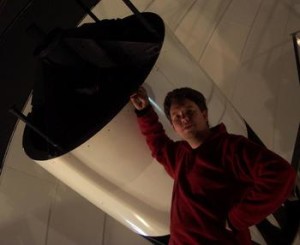
Stephen Kane, chief TERMIite, standing next to his magical starlight-catching, planet-finding bucket.
Regular readers know that I and my students are part of Stephen Kane’s TERMS consortium. TERMS seeks to find a long period transiting planet around a bright star, by cleverly noting that so many longer period planets are known from radial velocities that there’s a good chance that a few of them transit. This means we need to accurately calculate the orbital ephemerides of all of these planets and go watching their host stars for when they are in inferior conjunction (lined up). If we check them all, sooner or later we’ll find one that happens to have its orbital plane lined up with our line of sight, and we’ll see a transit.
One of our first forays into this was Sharon Wang’s paper on HD 37605. Sharon used whole troves of radial velocities to get a sufficiently precise ephemeris for HD 37605b, that the MOST satellite could search for transits. We ruled them out at 100-σ, which is a dispositive null detection (i.e., we did not “fail to find a transit”, we found that it does not transit).

Natalie Hinkel, compiler of stellar abundances, exposer of underlying systematics therein, constructor of the Hypatia catalog, and presenter at the 18th Cambridge Workshop on Cool Stars, Stellar Systems, and the Sun
Well, TERMS is at it again. Natalie Hinkel has just published her work on the HD 130322 system. This star has a 11-day orbital companion, a roughly one Jupiter mass planet in an essentially circular orbit. Because the star is nearby, determining whether this planet transits is important: if it does, it would be one of the brightest stars to host a transiting giant planet, and one of the “coldest” such planets known (since, in this game, an 11-day orbit is actually very long, so the planet isn’t very close to its star).
Natalie has previously made a name for herself with the Hypatia catalog (named for the ancient Egyptian astronomer/philosopher), which compiled abundance measurements for nearby, bright stars from the literature, and revealed that all the groups doing this sort of work are getting inconsistent answers. Worse, she held a “stellar stoichiometry” workshop, where she challenged these groups to analyze the same data with the same assumptions — and they still all got inconsistent answers. This is an important issue for stellar astrophysicists to untangle.
But, back to the planets! Natalie put together a thorough analysis of this star: my former undergraduate Katherina Feng did the orbital analysis as part of her senior thesis, and she determined the transit time window using Sharon Wang’s BOOTTRAN routine.
Greg Henry then phased up his many years of photometry from his small telescope array at Fairborn Observatory at this period, to hunt for the transit. Greg’s amazing collection of photometry for this star is sensitive to transits at this period at the 0.3 millimagnitude level. Since a giant planet would generate a transit with a depth of 17 millimagnitudes, this is a a 50-σ null detection, which is dispositive. HD 130322 does not transit its star.*
So, one more TERMS target down. Stephen will catch his quarry eventually!
But there’s a lot more to this paper than this dispositive null result. We provided chromospheric activity measurements which phase up nicely with Greg’s photometry at the stellar cycle period of the star, which is 5.2 years. These data sets are anti-correlated, meaning that the star is slightly fainter (by 4 millimagnitudes = 0.4%!) during starspot maximum than during starspot minimum. This is opposite the behavior of the Sun, but typical for younger stars.
Greg uses those starspots to easily pick out the rotation period of the sun, which is 26.5 days, indeed faster than that of the (older) Sun.
So even though we’re ostensibly studying planets, we’re actually learning a lot about Sun-like stars and how they behave. Some might find this to be a necessary but boring step towards planets, but I actually find it to be one of the most interesting outputs of the exoplanet hunt.
Natalie’s paper is here.
*=Technically, it could still have just-barely-grazing transits. These can never be totally ruled out from transit photometry alone. Our dispositive null result is for non grazing transits (impact parameter less than 1-(R_planet / R_star).). Also, the planet could in principle have an outrageously high density — if it is actually Earth-radius (despite having a Jupiter mass) then we would not see it transit. Also, leprechauns might have shone tiny flashlights into the telescopes during the transits, ruining our experiment.

